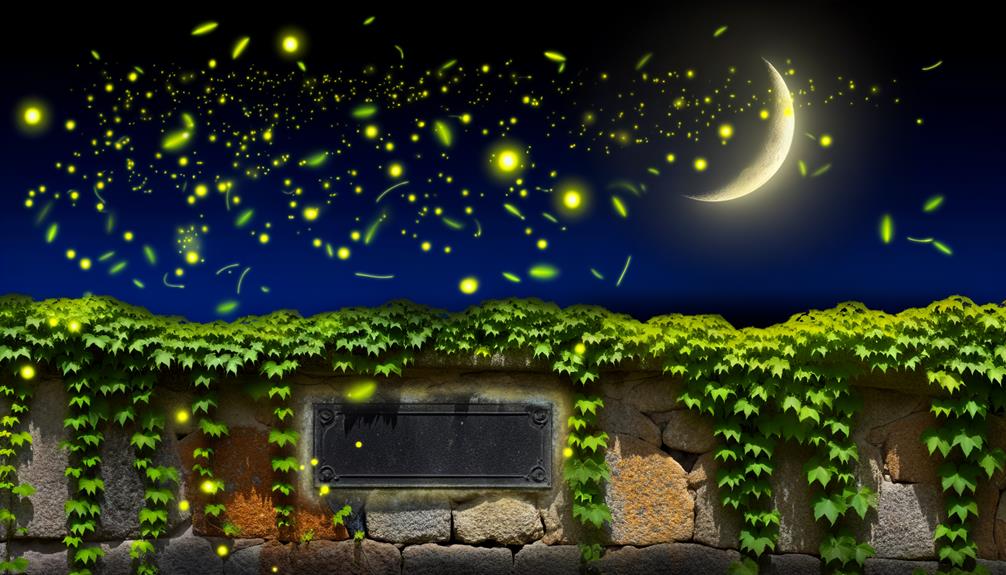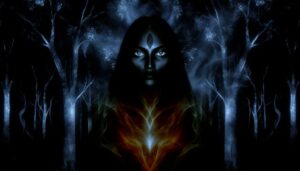Meaning of the Name Lamia
The name 'Lamia' originates from ancient Greek mythology and signifies a profound cultural and literary heritage. In mythology, Lamia is known as a malevolent spirit who preys on children and seduces men, embodying themes of transformation, divine punishment, and monstrous femininity.
Derived from the Greek word for 'throat,' the name encapsulates the devouring nature attributed to her character. In literature, particularly in John Keats' work, the figure of Lamia explores complex themes of beauty, tragedy, and desire.
The enduring fascination with Lamia extends to contemporary culture, where she symbolizes allure and danger in various artistic expressions. Uncovering further layers will reveal rich, intricate themes associated with her name.

Key Takeaways
- The name 'Lamia' originates from ancient Greek mythology, meaning 'gullet' or 'throat.'
- Lamia is associated with a mythological creature that preys on children and seduces men.
- The name symbolizes themes of transformation, monstrosity, and divine punishment.
- Lamia represents destructive jealousy and societal fears of female power and otherness.
- In contemporary culture, Lamia is used to depict mysterious, malevolent, and alluring characters.
Ancient Greek Mythology
In Ancient Greek mythology, Lamia is depicted as a malevolent spirit who preys on children and seduces men, embodying the intersection of fear and fascination within the cultural psyche. This character's origins trace back to tragic tales of loss and transformation.
Lamia, once a beautiful queen loved by Zeus, was driven to madness and monstrosity by Hera's jealousy. Her transformation into a child-devouring entity serves as a cautionary tale about the destructive potential of divine wrath. Additionally, Lamia's seduction of men underscores the era's anxieties about female sexuality and power.
Through Lamia, Greek mythology channels societal fears and moral lessons, rendering her an enduring symbol of terror and allure that resonates through time.
Lamia in Literature
The name Lamia, originating from ancient Greek mythology, has permeated various literary works, often symbolizing both allure and danger.
John Keats' poem 'Lamia' reinterprets this mythical creature, exploring themes of love and transformation through a romantic lens.
Modern literature continues to reference Lamia, reflecting ongoing fascination with her dual nature as both seductress and monster.
Mythical Creature Origins
Lamia's mythological origins trace back to ancient Greek literature, where she is depicted as a formidable creature embodying both beauty and terror. Her story is steeped in tragedy and horror, capturing the imagination and fears of many.
Lamia was once a beautiful queen, transformed into a monster by Hera's wrath. This duality of beauty and monstrosity serves as a potent symbol of the following:
- Maternal Loss: Lamia's transformation is a consequence of losing her children, evoking deep empathy.
- Divine Punishment: Her fate illustrates the merciless nature of divine retribution.
- Seduction and Danger: Lamia's allure masks a lethal threat, blending attraction with peril.
- Cultural Warning: Her tale serves as a cautionary narrative against unchecked desires and vengeance.
Understanding Lamia's origins offers profound insights into ancient Greek cultural and moral paradigms.
Keats' Poetic Interpretation
John Keats' portrayal of Lamia in his eponymous poem enhances the myth to a deep exploration of beauty, tragedy, and the intricacies of human desire. Keats reimagines Lamia, not just as a monstrous figure, but as a symbol of enchantment and sorrow.
Through his rich, evocative language and complex verse, Keats intertwines Lamia's serpentine transformation with the fleeting nature of human passion. Set against a backdrop of Grecian mythology, the poem explores the tension between reality and illusion, capturing the temporary beauty of Lamia's love affair with Lycius.
Keats' Lamia is therefore a poignant commentary on the ephemeral and often painful nature of idealized love, reflecting broader Romantic themes of yearning and disillusionment.
Modern Literary References
In contemporary literature, Lamia continues to serve as a powerful symbol, weaving through narratives to explore themes of transformation, seduction, and the duality of human nature. Authors have reimagined this ancient figure to reflect modern anxieties and human complexities. Lamia's portrayal often explores the following:
- Transformation: Characters undergo profound changes, echoing Lamia's own metamorphosis.
- Seduction: The allure and danger of Lamia embody the enticing yet risky aspects of human desires.
- Duality: Lamia symbolizes the eternal conflict between light and dark within human souls.
- Empowerment: Modern narratives frequently reinterpret Lamia as a figure of feminine strength and autonomy.
These elements underscore Lamia's enduring relevance, capturing the cultural zeitgeist and universal human struggles.
Cultural Significance
The name Lamia holds profound cultural significance across various societies, often evoking themes of mysticism and folklore.
In ancient Greek mythology, Lamia is depicted as a queen turned into a monstrous figure due to her tragic fate, symbolizing the intersection of beauty and horror. This duality is echoed in various Mediterranean and European traditions where Lamia embodies both a seductress and a fearsome entity. Her tale often serves as a cautionary narrative about the perils of vengeance and unrestrained desire.
Additionally, in Arabic folklore, Lamia is sometimes associated with demonic figures, further enriching her complex cultural tapestry. Consequently, the name Lamia resonates deeply within the collective consciousness, serving as a potent symbol of transformation and duality.
Modern Interpretations
In the world of modern interpretations, the name Lamia has permeated various facets of popular culture, influencing literature, film, and television. Contemporary naming trends reflect a nuanced revival of mythological names, wherein Lamia's historical and cultural resonance plays a significant role.
The ongoing fascination with mythological influences continues to shape its perception in today's society, highlighting the enduring impact of ancient narratives on modern identities.
Popular Culture References
Although originating from ancient myth, the name Lamia has been reinterpreted in various modern cultural narratives, often embodying themes of seduction, mystery, and transformation. This enduring name weaves through different genres, reflecting its complex legacy.
- Literature: In John Keats' poem 'Lamia,' the name encapsulates the tension between beauty and danger, highlighting the enchantress who captivates and ensnares.
- Film: The character Lamia in Neil Gaiman's 'Stardust' is portrayed as a powerful witch, emphasizing themes of eternal youth and dark allure.
- Television: In the series 'Doctor Who,' Lamia appears as a scientist, blending intellect with a shadowy past.
- Video Games: In the 'Final Fantasy' series, Lamia often appears as a serpentine enemy, reinforcing her mythological roots.
Contemporary Name Trends
Modern interpretations of the name Lamia extend beyond its mythological and cultural origins, reflecting evolving trends in contemporary naming practices and societal values. The name Lamia, once imbued with dark folklore, has reemerged as a unique and sophisticated choice, embraced for its phonetic elegance and distinctive character. Parents today increasingly seek names that blend historical depth with modern appeal.
| Trend | Description | Example |
|---|---|---|
| Historical Revival | Rediscovery of classical names | Lamia as a refined choice |
| Phonetic Appeal | Emphasis on sound and pronunciation | Lamia's melodic quality |
| Cultural Fusion | Integration of diverse cultural elements | Lamia's multicultural roots |
This evolution underscores a broader shift towards names that resonate with both tradition and modernity.
Modern Mythological Influence
Frequently drawing from ancient tales, contemporary interpretations of mythological names like Lamia reflect a nuanced blend of reverence for folklore and a desire for individuality in modern naming conventions. This duality in naming trends reveals a complex cultural tapestry where historical narratives are given new life.
Modern influences have imbued the name Lamia with an allure that transcends its dark origins, projecting a sense of mystery and strength.
Consider the following emotional resonances associated with the name Lamia:
- Mystique: Evoking an aura of the enigmatic and the unknown.
- Strength: Reflecting inner resilience and power.
- Rebirth: Symbolizing transformation and renewal.
- Individuality: Celebrating uniqueness and personal identity.
These facets demonstrate the evolving cultural significance of mythological names in contemporary society.
Linguistic Origins
The name 'Lamia' traces its linguistic origins to ancient Greek mythology, where it was used to denote a fearsome creature often depicted as a serpentine woman. The term is derived from the Greek word 'λαμία' (lamia), which can be translated to mean 'gullet' or 'throat,' reflecting the mythological creature's association with devouring children.
This etymology underscores the cultural significance of the name, encapsulating both fear and fascination. In classical literature, Lamia was a queen transformed into a monster by the gods, symbolizing themes of punishment and transformation.
Understanding the linguistic roots of 'Lamia' offers a nuanced perspective on its enduring resonance in mythological and literary contexts, revealing layers of historical and cultural meaning embedded in the name.
Symbolism and Themes
Central to the name 'Lamia' are themes of transformation, monstrosity, and punishment, which provide a rich tapestry for exploring its cultural and mythological symbolism.
In Greek mythology, Lamia was a beautiful queen turned into a child-eating monster by Hera, symbolizing the destructive power of jealousy and vengeance. Her transformation underscores the fragility of beauty and innocence, while her monstrosity reflects societal fears of the 'other.' This myth also illustrates the harsh consequences of divine punishment.
To evoke deeper emotional connection, consider:
- Transformation: From beauty to beast.
- Monstrosity: Embodying societal fears.
- Punishment: Resulting from divine wrath.
- Despair: Eternal suffering and loss.
These themes resonate across cultures, enriching the narrative of Lamia.
Lamia in Art
Exploring the representation of Lamia in art reveals how artists across ages have interpreted and visualized the myth's themes of transformation, monstrosity, and punishment.
In Renaissance paintings, Lamia is often depicted as a beautiful woman whose lower body transforms into that of a serpent, symbolizing her dual nature and the curse imposed upon her.
Romantic artists, like John William Waterhouse, emphasized her tragic allure, portraying her as a melancholic figure ensnared by her fate.
These artworks not only reflect the mythological narrative but also convey deeper societal fears about female power and otherness.
Contemporary Usage
In contemporary culture, the name Lamia often resurfaces in literature, film, and popular media, symbolizing themes of seduction, danger, and the supernatural. This multifaceted representation reflects deep-rooted archetypes and collective anxieties.
Literature: The name appears in modern fantasy novels, evoking mysterious and often malevolent characters.
Film: Lamia is frequently portrayed in horror and fantasy genres, emphasizing her menacing allure.
Music: Artists draw on the name Lamia to convey dark, seductive themes in their lyrics and imagery.
Television: Shows often feature characters named Lamia to add layers of intrigue and complexity.
These recurrent uses underscore the enduring resonance of Lamia as a symbol of both fascination and fear in contemporary culture.
Conclusion
The name Lamia, deeply rooted in ancient Greek mythology, has evolved through literature, art, and cultural contexts, embodying themes of seduction, danger, and transformation.
Its linguistic origins and symbolic meanings have influenced various interpretations, from classical texts to modern adaptations.
What enduring fascination does this enigmatic figure hold in contemporary society? Exploring Lamia's multifaceted representations reveals a complex interplay between historical narrative and contemporary imagination.






